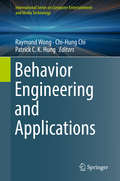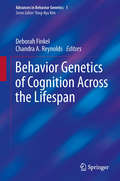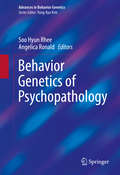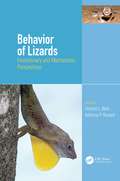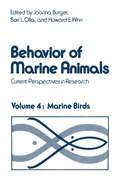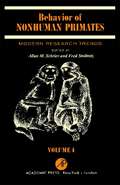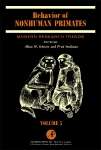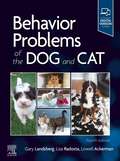- Table View
- List View
Behavior Engineering and Applications (International Series on Computer Entertainment and Media Technology)
by Raymond Wong Chi-Hung Chi Patrick C. HungMany industrial applications built today are increasingly using emerging behavior engineering technologies: this book looks at various research and practical issues for researchers and students working in computer science and engineering, and for industry technology providers interested in behavior engineering and applications. Behavior Engineering and Applications encompasses intelligent and efficient computational solutions, including models, architectures, algorithms and specific applications, focused on processing, discovering, understanding and analyzing the behavior captured by the above data. Focusing on applying any engineering paradigm to systemically process, discover, understand and analyze these data, this book also addresses problems in a variety of areas and applications that related to behavior engineering.This book includes chapters derived from selected papers from The 2016 International Conference on Behavior Engineering (ICBE), as well as separate contributions the editors selected cutting-edge research related to behavior engineering.
Behavior Genetics of Cognition Across the Lifespan (Advances in Behavior Genetics #1)
by Deborah Finkel Chandra A. ReynoldsAlong with psychopathology, cognition has been one of the primary phenotypic focal points of the field of behavior genetics since its inception. Francis Galton’s 1874 examination of eminent families in Britain was among the earliest attempts to investigate whether cognitive achievements run in families. This volume presents current methodologies for understanding cognitive abilities that move beyond the outdated nature vs. nurture paradigm. Recent advances in both collection and statistical modeling of twin data, particularly longitudinal twin data, make this an especially advantageous moment to produce a work that presents a collection of the groundbreaking research on cognitive abilities across the lifespan. This volume presents an overview of the current state of quantitative and molecular genetic investigations into the many facets of cognitive performance and functioning across the lifespan.
Behavior Genetics of Psychopathology (Advances in Behavior Genetics #2)
by Soo Hyun Rhee Angelica RonaldAs a dynamic, interdisciplinary field, behavior genetics and its evolution are being followed closely by scientists across the psychological and medical domains. The discoveries surrounding the human genome and the advancement in molecular genetic technologies have led to studies becoming increasingly sophisticated and yielding yet more conclusive and useful results. This is certainly the case in the area of child and adult psychopathology. Behavior Genetics of Psychopathology summarizes the state of the field, examiningthe role of genes and environment as they affect common neurodevelopmental and psychiatric conditions. Emphasizing key research areas (comorbidities, twin studies, the integration of methods), the book assesses the current literature, offers up-to-date findings, sorts through lingering controversies, and identifies a clear future agenda for the field. Expertly-written chapters focus on issues of both general salience that shape behavior genetics of psychopathology, to specific disorders of major clinical importance, among them: ADHD: the view from quantitative genetic research.Autism spectrum disorders and their complex heterogeneityGenetic influences on anxiety and depression in childhood and adolescence.Evidence for etiologically-defined subgroups within the construct of antisocial behavior.Sleep and psychopathology: the reasons for their co-occurrence. Behavioral genetic approaches to the etiology of comorbidity.Epigenetics of psychopathology. This combination of timeliness and depth of coverage make Behavior Genetics of Psychopathology a frontline resource for behavior geneticists, psychologists, psychiatrists, and neuroscientists, and is perfectly suited to graduate students looking to join these fields.
Behavior Genetics of Temperament and Personality (Advances in Behavior Genetics)
by Kimberly J. Saudino Jody M. GanibanThis volume examines behavioral genetic research on temperament and personality from a number of perspectives. It takes a developmental perspective on a number of issues across the lifespan, focusing on personality and temperament. The first section focuses on the development of temperament and personality. Typically this has involved exploring genetic and environmental contributions to phenotypic stability and instability, but more recently there has been research that examines the etiology of intra-individual change/growth trajectories. The second section examines genetic and environmental contributions to the association between temperament and personality and other behaviors. The third and fourth sections discuss genotype-environment correlations and interactions, and introduces the reader to molecular genetics research on temperament and personality. Chapter 11 will discuss the significance of this type of research and Chapter 12 will provide an example of specific line of research exploring genes associated with temperament.
The Behavior of Animals: Mechanisms, Function, and Evolution
by Johan J. Bolhuis Luc-Alain Giraldeau Jerry A. HoganThe Behavior of Animals An updated view of animal behavior studies, featuring global experts The Behavior of Animals, Second Edition provides a broad overview of the current state of animal behavior studies with contributions from international experts. This edition includes new chapters on hormones and behavior, individuality, and human evolution. All chapters have been thoroughly revised and updated, and are supported by color illustrations, informative callouts, and accessible presentation of technical information. Provides an introduction to the study of animal behavior Looks at an extensive scope of topics- from perception, motivation and emotion, biological rhythms, and animal learning to animal cognition, communication, mate choice, and individuality. Explores the evolution of animal behavior including a critical evaluation of the assumption that human beings can be studied as if they were any other animal species. Students will benefit from an updated textbook in which a variety of contributors provide their expertise and global perspective in specialized areas
The Behavior of Animals: Mechanisms, Function, and Evolution
by Luc-Alain Giraldeau Johan Bolhuis Jerry A. HoganThe Behavior of Animals An updated view of animal behavior studies, featuring global experts The Behavior of Animals, Second Edition provides a broad overview of the current state of animal behavior studies with contributions from international experts. This edition includes new chapters on hormones and behavior, individuality, and human evolution. All chapters have been thoroughly revised and updated, and are supported by color illustrations, informative callouts, and accessible presentation of technical information. Provides an introduction to the study of animal behavior Looks at an extensive scope of topics- from perception, motivation and emotion, biological rhythms, and animal learning to animal cognition, communication, mate choice, and individuality. Explores the evolution of animal behavior including a critical evaluation of the assumption that human beings can be studied as if they were any other animal species. Students will benefit from an updated textbook in which a variety of contributors provide their expertise and global perspective in specialized areas
Behavior of Exotic Pets
by Valarie V. TynesBehavior of Exotic Pets is the first book on the subject to be written by behavioral experts, all with a wealth of practical experience. Divided into species-specific chapters, the book explains the normal behavior for each group of animals, including reproduction, parenting, communication and social behavior. The book also addresses animals’ environmental needs based on their behavior to enable owners to provide better husbandry and avoid potential problems. Descriptions of common behavioral problems are included, with practical recommendations for their treatment or management. This text is essential for any veterinary professional who would like to improve their knowledge of exotic animal behavior. It also serves as a valuable reference for animal behaviorists, exotic animal veterinarians, veterinary students, and anyone caring for these animals in captivity. Key features: The first and only book on exotic pet behavior written by behaviorists Covers a wide range of exotic pet species Discusses methods for treating and managing common behavioral problems Offers practical advice on topics such as housing and handling of animals Includes separate chapters on learning, welfare, and behavioral pharmacology
Behavior of Exotic Pets
by Valarie V. TynesBehavior of Exotic Pets is the first book on the subject to be written by behavioral experts, all with a wealth of practical experience. Divided into species-specific chapters, the book explains the normal behavior for each group of animals, including reproduction, parenting, communication and social behavior. The book also addresses animals’ environmental needs based on their behavior to enable owners to provide better husbandry and avoid potential problems. Descriptions of common behavioral problems are included, with practical recommendations for their treatment or management. This text is essential for any veterinary professional who would like to improve their knowledge of exotic animal behavior. It also serves as a valuable reference for animal behaviorists, exotic animal veterinarians, veterinary students, and anyone caring for these animals in captivity. Key features: The first and only book on exotic pet behavior written by behaviorists Covers a wide range of exotic pet species Discusses methods for treating and managing common behavioral problems Offers practical advice on topics such as housing and handling of animals Includes separate chapters on learning, welfare, and behavioral pharmacology
Behavior of Lizards: Evolutionary and Mechanistic Perspectives
by Vincent L. Bels Anthony P. RussellKey features: Presents a contemporary snapshot of the mechanisms underlying the evolution and adaptation of behavior Explores how genetics, epigenetics, development, and environment shape behavior Discusses a broad range of behavioral repertoires and responses, including those related to thermoregulatory, foraging, predatory, displaying, social and escape strategies. Examines physiological and sensory mechanisms Covers the effects of various aspects of global change on behavior, with chapters that focus on the impacts of climate change on hydroregulatory behavior and behavioral responses to the effects of habitat alteration resulting from human-mediated change and colonization by invasive species. Lizards serve as focal organisms for many of biological questions related to evolution, ecology, physiology, and morphology. They are studied at multiple spatial and temporal scales, from the individual to the community level. This book, authored by expert contributors from around the world, explores behaviors underlying the evolution and adaptation of these organisms. It covers conceptual, empirical, and methodological approaches to the understanding of the role that natural and sexual selection play in molding the behavioral traits of lizards. This thorough, illustrated reference should stimulate discussion of the conceptual and methodological approaches for studying the behavioral traits of these fascinating and highly diverse vertebrates.
Behavior of Lizards: Evolutionary and Mechanistic Perspectives
by Vincent Bels Anthony RussellKey features: Presents a contemporary snapshot of the mechanisms underlying the evolution and adaptation of behavior Explores how genetics, epigenetics, development, and environment shape behavior Discusses a broad range of behavioral repertoires and responses, including those related to thermoregulatory, foraging, predatory, displaying, social and escape strategies. Examines physiological and sensory mechanisms Covers the effects of various aspects of global change on behavior, with chapters that focus on the impacts of climate change on hydroregulatory behavior and behavioral responses to the effects of habitat alteration resulting from human-mediated change and colonization by invasive species. Lizards serve as focal organisms for many of biological questions related to evolution, ecology, physiology, and morphology. They are studied at multiple spatial and temporal scales, from the individual to the community level. This book, authored by expert contributors from around the world, explores behaviors underlying the evolution and adaptation of these organisms. It covers conceptual, empirical, and methodological approaches to the understanding of the role that natural and sexual selection play in molding the behavioral traits of lizards. This thorough, illustrated reference should stimulate discussion of the conceptual and methodological approaches for studying the behavioral traits of these fascinating and highly diverse vertebrates.
Behavior of Marine Animals: Current Perspectives in Research. Marine Birds
by Joanna Burger Bori L. Olla Howard E. WinnThe maJonty of the chapters in this volume are structured to include a balance between literature review, original data, and synthesis. The research approaches taken by the authors are generallyof two kinds. One centers on the long-term, in-depth study of a single species in which many aspects of its natural history are examined in detail. The other is a comparative one which involves investigating particular questions by examining species or by comparing groups of species that may include taxonomic andjor ecological affinities. Most of the chapters concern obvious aspects of breeding behavior including habitat selection, the effects of age on breeding, communication, mating systems, synchrony of breeding activities, development of behavior, prefledging parental care, and postfledging parental care. Of these topics, many relate directly to the advantages and disadvantages of coloniality-a conspicuous behavior pattern in marine birds. As such, they provide para.picuou for the further study of coloniality and the social behaviorof many other animals. Other important areas of marine bird breeding behavior (such as courtship behavior, antipredator behavior, information transfer) have not been included because of space limitations. Since man's encroachment on the seashore and continental shelf poses certain threats to marine birds, a volume elucidating various aspects of their biology has multiple uses. As weil as being of value to ornithologists, the volume should be useful to managers involved with coastal planning.
Behavior of Marine Animals: Current Perspectives in Research Volume 1: Invertebrates
by Howard E. Winn Bori L. OllaWhat have been brought together in these volumes are works represent ing a variety of modern quantitative studies on a select group of marine organisms. Some of the species studied here represent basic biological ex perimental subjects-in some cases, marine versions of the white rat and pigeon-that are being used for a wide range of studies. Other species studied were virtually unknown as experimental animals. The authors have studied their animals in considerable depth, often in both the field and the laboratory. It is this cross reference between real life and the artificial but controlled conditions of the laboratory which gives us the necessary understanding, and ultimately the means, for improving our rapidly deteriorating environment, a must for man's survival, maintenance, and improvement of the quality of living standards. A direct outgrowth of a AAAS symposium entitled "Recent Advances in the Behavior of Marine Organisms" held in December 1966, these vol umes include a reasonable balance between review and original unpublished research. Of the many persons who have made these volumes possible, we wish to especially thank Nancy Fish, Lois Winn, Mabel Trafford, and Deborah Brennan. The latter two accomplished most of the final editorial work. The personnel of Plenum Press were cooperative in all aspects of our rela tionship. Only the two editors are responsible for defects in the volumes. We believe the papers presented are significant and will be of importance to members of the scientific community.
Behavior of Marine Animals: Current Perspectives in Research Volume 2: Vertebrates
by Howard E. Winn Bori L. OllaWhat have been brought together in these volumes are works represent ing a variety of modern quantitative studies on a select group of marine organisms. Some of the species studied here represent basic biological ex perimental subjects-in some cases, marine versions of the white rat and pigeon-that are being used for a wide range of studies. Other species studied were virtually unknown as experimental animals. The authors have studied their animals in considerable depth, often in both the field and the laboratory. It is this cross reference between real life and the artificial but controlled conditions of the laboratory which gives us the necessary understanding, and ultimately the means, for improving our rapidly deteriorating environment, a must for man's survival, maintenance, and improvement of the quality of living standards. A direct outgrowth of a AAAS symposium entitled "Recent Advances in the Behavior of Marine Organisms" held in December 1966, these vol umes include a reasonable balance between review and original unpublished research. Of the many persons who have made these volumes possible, we wish to especially thank Nancy Fish, Lois Wino, Mabel Trafford, and Deborah Brennan. The latter two accomplished most of the final editorial work. The personnel of Plenum Press were cooperative in all aspects of our rela tionship. Only the two editors are responsible for defects in the volumes. We believe the papers presented are significant and will be of importance to members of the scientific community.
Behavior of Marine Animals: Current Perspectives in Research
by Howard E. Winn Bori L. OllaFour years ago we began soliciting articles for this volume from authors who were engaged in comprehensive research on whales. From the outset we decided not to limit the subject matter to behavior but to also include natural history. Much of what is known about the behavior of whales arose from studies whose principal aim was not behavior, much as it did for other animal groups before behavior was considered a distinct discipline. Thus in many of the articles behavior is closely intertwined with natural history and in others is completely overshadowed by a basic natural history approach. Our aim was to have the articles contain a review of the literature and include research findings not previously published. For all intents and purposes this aim has been realized, albeit perhaps not in as balanced a fashion in terms of species or subject matter as was originally planned. Nevertheless, we believe the articles present a wide range of informative works with a myriad of approaches and techniques represented. We are grateful to the contributors for their patience and understanding in awaiting publication, which has taken much longer than we originally expected. We are also grateful tor the assistance of a number of people, especially Julie Fischer and Lois Winn for their editorial efforts, and Jill Grover, Carol Samet, and Lois Winn for their help in indexing.
Behavior of Nonhuman Primates: Modern Research Trends
by Allan M. Schrier Harry F. Harlow Fred StollnitzBehavior of Nonhuman Primates: Modern Research Trends focuses on research on the behavior of nonhuman primates, including social behavior, life history, and discrimination. The selection first offers information on the affectional systems and determinants of social behavior in young chimpanzees. Topics include infant-mother, maternal, age-mate or peer, and paternal affectional systems, social behavior of young chimpanzees, and the effects of arousal level on social responsiveness. The publication also takes a look at ontogeny of perception and learning and age changes in chimpanzees. Discussions focus on performance on formal tests of behavior, life history, classical conditioning, locomotion and manipulation, single-problem discrimination, and learning sets. The manuscript examines investigative behavior, as well as maintenance of behavior in nonhuman primates by investigatable rewards and determinants of investigative behavior. The publication also evaluates the radiation syndrome and field studies. The selection is a dependable reference for readers interested in the behavior of nonhuman primates.
Behavior of Nonhuman Primates: Modern Research Trends (ISSN #Volume 1)
by Allan M. Schrier Harry F. Harlow Fred StollnitzBehavior of Nonhuman Primates: Modern Research Trends, Volume I focuses on studies on the dynamics of behavior of nonhuman primates.The selection first offers information on discrete-trial training techniques and stimulus variables and discrimination-learning sets. Discussions focus on the characteristics of learning-set behavior, procedural variables, basic learning-set procedures, renaissance of contiguity, border cues and additivity, and contiguity and automation. The text then ponders on hypothesis behavior and delayed-response problem, including variations of the delayed-response problem; delayed response and discrimination learning contrasted; and the hypothesis model and its application to the object-discrimination-learning-set experiment.The manuscript examines associative problems and operant conditioning. Topics include discriminative behavior, similarity and dissimilarity problems, alternation problems, discrimination reversal problems, discrimination problems, and behavior controlled by aversive stimuli.The text is a valuable reference for researchers interested in the behavior of nonhuman primates.
Behavior of Nonhuman Primates: Modern Research Trends (ISSN #Volume 4)
by Allan M. Schrier Fred StollnitzBehavior of Nonhuman Primates: Modern Research Trends, Volume 4 provides information pertinent to research on behavior of nonhuman primates. This book presents a systematic investigation of memory processes in animals.Organized into four chapters, this volume begins with an overview of the implication of the obvious similarity of monkeys and humans in interproblem learning. This text then presents a series of investigations of the retention of object-discrimination learning by learning-set-experienced rhesus monkeys. Other chapters consider the capability of chimpanzees to handle at least rudimentary stages of certain higher mental functions. This book discusses as well the communicative behavior of animals, which is similar to the rest of animal behavior in that it is governed by general perceptual, motor, motivational, and associative laws. The final chapter deals with the main accomplishments of a program designed to teach language to a chimpanzee.This book is a valuable resource for students and research workers.
Behavior of Nonhuman Primates: Modern Research Trends (ISSN #Volume 3)
by Allan M. Schrier Fred StollnitzBehavior of Nonhuman Primates: Modern Research Trends, Volume 3 provides information pertinent to research on behavior of nonhuman primates. This book presents the knowledge of the social development of rhesus infants and compares with data on other species.Organized into four chapters, this volume begins with an overview of the interspecies differences in the social influences affecting young primates. This text then examines the nature of the interactions between the infant and its various social companions, wherein each type of social companion may interact with the infant in a number of ways. Other chapters consider the nature of the social organization, which may be presumed to have been shaped by the ecological pressures of the natural habitat. This book discusses as well the color vision and visual acuity in different animals. The final chapter deals with the aspects of primate hearing.This book is a valuable resource for students and research workers.
Behavior of Nonhuman Primates: Modern Research Trends (ISSN #Volume 5)
by Allan M. Schrier Fred StollnitzBehavior of Nonhuman Primates: Modern Research Trends, Volume 5 is a collection of papers on research trends in the study of the various aspects of primate behavior. Chapters in the book discuss topics on the history of the study of cognitive processes in primates; ways in which visual stimuli in monkeys are perceived, stored in memory, and retrieved; and behavior of prosimians. The book will be of value to primatologists, psychologists, and zoologists.
The Behavior of the Laboratory Rat: A Handbook with Tests
by Ian Q. Whishaw Bryan KolbBoth seasoned and beginning investigators will be amazed at the range and complexity of rat behavior as described in the 43 chapters of this volume. The behavioral descriptions are closely tied to the laboratory methods from which they were derived, thus allowing the investigator to exploit both the behavior and the methods for their own research. It will also serve as an indispensable reference for other neuroscientists, psychologist, pharmacologists, geneticists, molecular biologists, zoologists, and their students and trainees.
Behavior Problems of the Dog and Cat: Behavior Problems of the Dog and Cat - E-Book
by Gary Landsberg Lisa Radosta Lowell AckermanBehavior Problems of the Dog & Cat, 4th Edition retains the highly practical approach that has proved so successful in previous editions, offering diagnostic guidelines, preventive advice, treatment guidelines and charts, case examples, client forms and handouts, and product and resource suggestions, along with details on the use of drugs and natural supplements to help optimize the behavior services offered in practice. Step-by-step guidelines describe how to collect a patient history, perform a thorough physical examination, conduct diagnostic testing, formulate differential diagnoses, select treatment, and monitor the patients’ responses. Background information describes how dog and cat behavior problems arise and how they can be prevented. Coverage of behavior modification techniques provides you with a clear understanding of suggested treatment as well as the use of drugs, products, pheromones, surgery, diet, and alternative therapies. Content on behavioral genetics explores this rapidly growing and advancing field and includes new therapeutic approaches for cognitive decline. Case studies illustrate real-life clinical situations. Easy-access treatment tables provide at-a-glance solutions to common behavior problems. Useful appendices include treatment protocols as well as the drug information and dosages that make effective prescribing easy. NEW! Many hot new topics are covered, including fear, anxiety, and stress and their effects on health and behavior, as well as pain and behavior, the psychobiological approach to veterinary behavior assessment, and pets and the family dynamic. NEW! Updated chapter content is extensively augmented or completely rewritten by new authors, making this more than just a new edition – it’s a new book! NEW! eBook version is included with print purchase which allows access to all of the text, figures, and references, with the ability to search, customize content, make notes and highlights, and have content read aloud. Online access also includes handouts and forms, drug dosing, and a comprehensive directory of resources.
Behavior Problems of the Dog and Cat - E-Book
by Gary Landsberg Wayne Hunthausen Lowell AckermanFormerly the Handbook of Behavior Problems of the Dog and Cat, the new edition of the definitive guide to the diagnosis and treatment of behavior problems of the dog and cat has been extensively updated. It retains the highly practical approach that has proved so successful in previous editions, offering diagnostic guidelines, preventative advice, treatment guidelines and charts, case examples, client forms and handouts, and product and resource suggestions along with details on the use of drugs and natural supplements to help optimize the behavior services offered in practice. To add to these features, the third edition is now fully referenced, there is significant new content, the book as been written with the entire hospital team in mind, and many color images have been added. The new edition welcomes a wide international mix of new contributors from Australia, Spain, Mexico and the United States. A website link gives access to the handouts and forms previously found on disk. As well as fulfilling its original purpose as a practical tool for the busy clinician, this edition offers valuable and useful support material for all those studying the field of companion animal behavior. Now in full color and using a revised format, Behavior Problems of the Dog and Cat remains the most complete, up-to-date and practical resource for the treating and diagnosing canine and feline behavior problems.
Behavior Science Perspectives on Culture and Community (Behavior Analysis: Theory, Research, and Practice)
by Traci M. Cihon Mark A. MattainiAll science proceeds by progressively building on the work of others while remaining open to new discoveries and challenging existing conceptual frameworks. The same is true of culturo-behavior science.This textbook presents the scientifically rigorous work of the last several decades that has taken a behavior-analytic view of social and cultural processes, with an eye for contributions that address social and cultural issues. The chapters herein explore and elaborate on the history, theories, and methodologies of culturo-behavior science and those of its researchers and practitioners. Throughout this volume, the authors intentionally prompt students to both learn from and question the current theory and methods while shaping their own research and practice.This book presents multiple intersecting perspectives intended for graduate-level students of behavior analysis. Contributors to this volume include many of the major scholars and practitioners conducting research and/or practicing in communities and larger cultural systems. Their work is scientifically guided, systemic, and ecologically valid; it includes basic research as well as efforts having applications in community health, sustainability, environmental issues, and social justice, among other matters. There is material here to support specialists preparing to do research or practice within community and cultural-level systems. As well, students who intend to do direct and clinical work will find the background they need to make contributions to the field as engaged, informed citizens.
Behavioral Biology of Laboratory Animals
by Kristine Coleman Steven J. SchapiroThis 30-chapter volume informs students and professionals about the behavioral biology of animals commonly housed in laboratory and other captive settings. Each species evolved under specific environmental conditions, resulting in unique behavioral patterns, many of which are maintained in captivity even after generations of breeding. Understanding natural behavior is therefore a critical part of modern animal care practices. The descriptions, data, guidance, resources, and recommendations in this book will help the reader understand their animals better, refine the care and treatment that they receive, and improve the well-being, welfare, and wellness of their animals. The book is divided into three sections, all focusing on aspects of the behavioral biology of animals found in laboratories and related research settings. After five introductory chapters, 25 chapters are dedicated to specific taxonomic groups (including mice, zebrafish, zebra finches, reptiles, macaques) while a concluding section of ethograms provides a centralized resource for those interested in understanding, and potentially quantifying, animal behavior. The Behaviorial Biology of Laboratory Animals will provide anyone working in maintenance, care, and/or research programs that involve laboratory animals with information about the way the animals live in the wild, and the way that they should live in captive research settings. Many of the guidelines and recommendations will also be valuable to those managing and working with animals in other environments, including zoological parks, aquaria, and sanctuaries.
